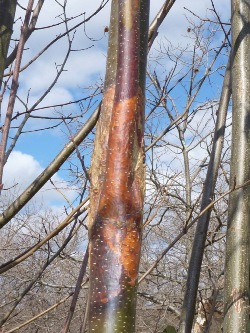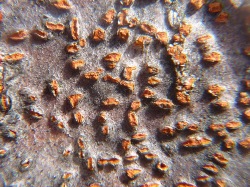
Chestnut blight
| Primefact number: 1446 Edition: 1st Published: February 2016 Author: Plant Biosecurity & Product Integrity |
Chestnut Blight is a plant disease caused by a fungus which mostly affects the trunk and branches of host trees.
After an outbreak in Victoria in 2010, the Victorian government is working with the chestnut industry to eradicate chestnut blight.
Notifiable status
Chestnut blight (Cryphonectria parasitica) is a notifiable plant disease in NSW.
All notifiable plant pests and diseases must be reported within 1 working day. You can report notifiable plant pests and diseases by one of the following methods:
- Call the Exotic Plant Pest Hotline 1800 084 881
- Email biosecurity@dpi.nsw.gov.au with a clear photo and your contact details
- Complete an online form
A full list of notifiable plant pests and diseases can be found in Schedule 2 of the NSW Biosecurity Act 2015.
Description

Chestnut blight is a bark-inhabiting fungus causing blight on stems and branches, and cankers that can grow rapidly.
Typical symptoms include discolouration of bark (Figure 1), cankers with orange stroma on the bark (Figure 2), basal cracking and trunk splitting, bark shedding, oozing resin, and necrosis.
A native fungus Holocryphia eucalypti can occasionally cause similar symptoms in chestnut trees and may be mistaken for chestnut blight.
Hosts
Chestnut species (Castanea spp.) are the most susceptible hosts. Oak (Quercus spp.), red maple (Acer rubrum), beech (Castanopsis spp.), staghorn (Rhustyphina spp.) and shagbark hickory (Carya ovate) are less susceptible.
Laboratory testing has shown Eucalyptus is also a host but this has not been observed in the field.
Damage
Cankers develop until the stem or branches are girdled, cutting off the supply of nutrients to the rest of the plant or branch. The tree will eventually become entirely infected and die.
The fungus affects the nutshell but does not affect seed germination or seedling growth.
Overseas, chestnut industries have been devastated by chestnut blight.
North American chestnut forests were severely altered by chestnut blight, causing mass tree death. It could impact native Eucalypt species in a similar way if it were to establish in Australia.
Lifecycle

Cryphonectria parasitica enters the host plant through wounds in the bark and then invades healthy tissue, forming stromas (Figure 2). Spread within the host can be rapid.
Wet weather triggers a release of large numbers of spores into the environment.
Spread
The disease can be spread on budding material or any infected trees or cuttings. It can also be spread by spores of the fungus.
There are two spore types. One is ejected from infected wood and spread by air. The other spore type is exuded from infected wood onto the surface where it can be spread by rain splash, water, or any object such as clothing, tools or equipment that the spores come into contact with.
Infected cut branches are also a serious risk of spread as the fungus grows more rapidly on dead wood and can produce spores for a year after cutting.
Distribution
Chestnut blight occurs in USA, Canada, Japan, China, Korea, and Europe.
Australian distribution
Chestnut blight was detected in north-east Victoria in 2010. An extensive eradication campaign is ongoing with monitoring to ensure no new outbreaks occur.
NSW DPI has conducted surveillance in all major chestnut growing regions in NSW with no detections.
Actions to minimise risk
Put in place biosecurity best practice actions to prevent entry, establishment and spread of pests and diseases:
- practice “Come clean, Go clean”
- ensure all staff and visitors are instructed in and adhere to your business management hygiene requirements
- monitor your crop regularly, particularly recently pruned or introduced trees.
- source plant material of a known high health status from reputable suppliers
- keep records

